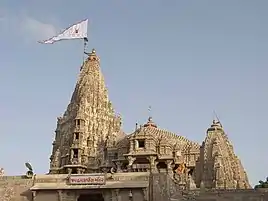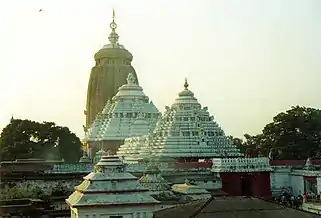Char Dham
The Char Dham (meaning: four abodes) is a set of four pilgrimage sites in India. It is believed that visiting these sites helps achieve moksha (salvation). The four Dhams are, Badrinath, Dwaraka, Puri and Rameswaram. It is believed that every Hindu should visit the char dhams during one's lifetime. The Char Dham as defined by Adi Shankaracharya consists of four Hindu pilgrimage sites.[1] Another small circuit in Uttarakhand of four pilgrimage sites-Yamunotri, Gangotri, Kedarnath, and Badrinath is referred to as Chota Char Dham.
| Char Dham
Dwaraka • Puri |
|---|
Historical description
According to Hindu belief, Badrinath became prominent when Nar-Narayan, an avatar of Vishnu, did Tapasya there. At that time that place was filled with berry trees. In Sanskrit language, berries are called "badri", so the place was named Badrika-Van, i.e. the forest of berries. The particular spot where the Nar-Narayan did Tapasya, a large berry tree formed covering Him to save Him from the rain and the sun. Local people believe that Mata Lakshmi became the berry tree to save Lord Narayan. Post-Tapasya, Narayan said, people will always take Her Name before His Name, hence Hindus always refer "Lakshmi-Narayan". It was therefore called Badri-Nath, i.e. the Lord of Berry forest. This all happened in the Satya Yuga. So Badrinath came to be known as the first Dham.
The second place, Rameswaram, got its importance in the Treta Yuga when Lord Rama built a Shiva-Lingam here and worshiped it to get the blessings of Lord Shiva. The name Rameswaram means "God of Ram".
The third, Dhaam Dwarka, got its importance in the Dvapara Yuga when Lord Krishna made Dwarka His residence instead of Mathura, His birthplace.[2]
At the fourth, Puri Dhaam, Lord Vishnu is worshiped as Jagannath, his Avtar for Kali Yuga.
The four Shankaracharya Peeth (Seats) at the Chaar Dham school of Hinduism, created at least four Hindu monastic institutions. He organised the Hindu practitioners under four Maṭhas (Sanskrit: मठ) (institutions/monasteries), with the headquarters at Dvārakā in the West, Jagannatha Puri in the East, Sringeri Sharada Peetham in the South and Badrikashrama in the North.[3]
The table below gives an overview of the four Amnaya Mathas founded by Adi Shankara, and their details.[4]
| Shishya (lineage) |
Direction | Maṭha | Mahāvākya | Veda | Sampradaya |
|---|---|---|---|---|---|
| Padmapāda | East | Govardhana Pīṭhaṃ | Prajñānam brahma (Consciousness is Brahman) | Rig Veda | Bhogavala |
| Sureśvara | South | Sringeri Śārada Pīṭhaṃ | Aham brahmāsmi (I am Brahman) | Yajur Veda | Bhūrivala |
| Hastāmalakācārya | West | Dvāraka Pīṭhaṃ | Tattvamasi (That thou art) | Sama Veda | Kitavala |
| Toṭakācārya | North | Jyotirmaṭha Pīṭhaṃ | Ayamātmā brahma (This Atman is Brahman) | Atharva Veda | Nandavala |
The four associated places of the Char dham
In the Puranas Hari (Vishnu) and Hara (Shiva) are referred as eternal friends. It is said wherever Lord Vishnu resides, Lord Shiva resides nearby. The Char Dham follows this rule. So Kedarnath is considered as the pair of Badrinath, Rama Setu is considered the pair of Rameswaram, Somnath is considered as the pair of Dwaraka. However, according to some traditions, the Char Dham are Badrinath, Rangnath-Swami, Dwarka and Jagannath-Puri, all of which are Vaishnava sites, and their associated places are Kedarnath, Rameswaram, Somnath and Lingaraja Temple, Bhubaneswar (or maybe Gupteshwar) respectively.
The Char Dham Highway project is still under completion and is proposed to get functional by end of 2018, but currently, many service providers offer a Char Dham Yatra by helicopter for the ease of pilgrims.[5]
Pilgrimage details
Puri
Puri located at the east, is located in the state of Odisha, India. Puri is one of the oldest cities in the eastern part of the country. It is situated on the coast of the Bay of Bengal. The main deity is Shri Krishna, celebrated as Lord Jagannatha. It is the only shrine in India, where goddess, Subhadra, sister of Lord Krishna is worshipped along with her brothers, Lord Jagannatha and Lord Balabhadra. The main temple here is about 1000 years old and constructed by Raja Choda Ganga Deva and Raja Tritiya Ananga Bhima Deva. Puri is the site of the Govardhana Matha, one of the four cardinal institutions or Mathas converted by Adi Shankaracharya. Pandit Nilakantha Das suggested that Jagannath was a deity of Jain origin because of the appending of Nath to many Jain Tirthankars.[6] Jagannath meant the 'World personified' in the Jain context and was derived from Jinanath. Evidence of the Jain terminology such as of Kaivalya, which means moksha or salvation, is found in the Jagannath tradition.[7] Similarly, the twenty two steps leading to the temple, called the Baisi Pahacha, have been proposed as symbolic reverence for the first 22 of the 24 Tirthankaras of Jainism.[8]
According to Annirudh Das, the original Jagannath deity was influenced by Jainism and is none other than the Jina of Kalinga taken to Magadha by Mahapadma Nanda.[9] The theory of Jain origins is supported by the Jain Hathigumpha inscription. It mentions the worship of a relic memorial in Khandagiri-Udayagiri, on the Kumara hill. This location is stated to be same as the Jagannath temple site. However, states Starza, a Jain text mentions the Jagannath shrine was restored by Jains, but the authenticity and date of this text is unclear.[10] This is the plume for Oriya people to celebrate a special day in this Dham which is known as Ratha Yatra ("Chariot Festival").[11][12]
Rameswaram
Rameswaram located in the South is in the Indian state of Tamil Nadu. It is situated in the Gulf of Mannar at the very tip of the Indian peninsula. According to legends, this is the place where Lord Ram along with his brother Laxman and devotee Hanuman built a bridge (Rama Setu) to reach Sri Lanka to rescue his wife Sita who had been abducted earlier by Ravan, the ruler of Sri Lanka. The Ramanatha Swamy Temple dedicated to Lord Shiva occupies a major area of Rameswaram. The temple is believed to have been consecrated by Shri Rama Chandra. Rameswaram is significant for the Hindus as a pilgrimage to Benaras is incomplete without a pilgrimage to Rameswaram. The presiding deity here is in the form of a Linga with the name Sri Ramanatha Swamy, it also is one of the twelve Jyotirlingas.
Dwarka
Dwarka located in the west is in the state of Gujarat, country India. The city derives its name from the word "dvar" meaning door or gate in the Sanskrit language. It is located confluence to where the Gomti River merges into the Arabian Sea. However, this river Gomti is not the same Gomti River which is a tributary of Ganga River The city lies in the westernmost part of India. The legendary city of Dwaraka was the dwelling place of Lord Krishna. It is generally believed that due to damage and destruction by the sea, Dvaraka had submerged six times and modern day Dwarka is the 7th such city to be built in the area.[13][14]
Badrinath
Badrinath is located in the state of Uttarakhand. It is in the Garhwal hills, on the banks of the Alaknanda River. The town lies between the Nar and Narayana mountain ranges and in the shadow of Nilkantha peak (6,560 m). There are other interesting sightseeing spots like Mana, Vyas Gufa, Maatamoorti, Charanpaduka, Bhimkund and the Mukh of the Saraswati River, within 3 km of Badrinathjee. Joshimath is situated on the slopes above the confluence of the rivers Alaknanda and Dhauliganga. Of the four Maths established by Adi Shankaracharya, Joshimath is the winter seat of Chardham.
While the three other Dhams remain open throughout the year, Badrinath Dham only remains open for pilgrims' darshan from April to October each year.
Chota Char Dham
Another circuit of four ancient pilgrimage sites in the Indian state of Uttarakhand viz. Yamunotri, Gangotri, Kedarnath, and Badrinath is referred to as Chota Char Dham to differentiate it from this bigger circuit of Char Dham sites. These Chota Char Dham shrines are closed in winter due to snowfall and reopen for pilgrims with the advent of summer.[15][16][17][18]
On 23 December 2016 the Indian Prime Minister Narendra Modi inaugurated the Chardham Mahamarg Vikas Pariyojana ("Chardham Highway Development Project") to improve connectivity between Gangotri, Yamunotri, Kedarnath and Badrinath making pilgrimages easier.[19]
See also
References
- Gwynne, Paul (2009), World Religions in Practice: A Comparative Introduction, Oxford: Blackwell Publication, ISBN 978-1-4051-6702-4
- Chakravarti Mahadev-1994-The Concept of Rudra-Śiva Through The Ages-Delhi-Motilal Banarsidass-Second Revised. ISBN 81-208-0053-2
- "Archived copy". Archived from the original on 8 May 2012. Retrieved 3 May 2009.CS1 maint: archived copy as title (link)
- The Amnaya Peethams | Sringeri Sharada Peetham Archived 26 June 2006 at the Wayback Machine
- "Why schools in Kedarnath are going soundproof - Times of India". The Times of India. Retrieved 3 November 2018.
- Mohanty, Jagannath (2009). Indian Culture and Education. Deep& Deep. p. 5. ISBN 978-81-8450-150-6.
- Barik, P M (July 2005). "Jainism and Buddhism in Jagannath culture" (PDF). Orissa Review: 36. Retrieved 29 November 2012.
- Avinash Patra (2011). Origin & Antiquity of the Cult of Lord Jagannath. Oxford University Press. pp. 8–10, 17–18.
- Das, Aniruddha. Jagannath and Nepal. pp. 9–10.
- O. M. Starza (1993). The Jagannatha Temple at Puri: Its Architecture, Art, and Cult. BRILL Academic. pp. 62–63 with footnotes. ISBN 90-04-09673-6.
- Char Dham Yatra, by G. R. Venkatraman. Published by Bharatiya Vidya Bhavan, 1988.
- Brockman, Norbert C. (2011), Encyclopedia of Sacred Places, California: ABC-CLIO, LLC, ISBN 978-1-59884-655-3
- Santosh, Urmila (22 November 2016). "Where Mythology Meets Reality: Sunken City Of Dwarka". gounesco.com. GoUNESCO. Retrieved 25 July 2019.
- Shankar, Kalyani (15 March 2007). "Legends by the sea". The Economic Times. Bennett, Coleman & Co. Ltd. Retrieved 25 July 2019.
- Char Dham of Garhwal India, by ffmgftfiokmdkgioftnsdtJoe Windless, Sarina Singh, James Bainbridge, Lindsay Brown, Mark Elliott, Stuart Butler. Published by Lonely Planet, 2007. ISBN 1-74104-308-5. Page 468.
- Chardham Yatra, by Savitri Dubey. Published by Alekh Prakashan. ISBN 978-81-88913-25-1
- "Welcome To Alekh Prakashan". Archived from the original on 23 December 2010. Retrieved 11 December 2019.
- "Char Dham and Hemkund Sahib Yatra to restart from May 2014". IANS. news.biharprabha.com. 24 April 2014. Retrieved 24 April 2014.
- FE Online (27 December 2016). "Chardham highway project: PM Modi lays foundation stone in Dehradun; here's why it's special". The Financial Express. Noida, Uttar Pradesh. Retrieved 12 August 2017.
External links
 Media related to Char Dham at Wikimedia Commons
Media related to Char Dham at Wikimedia Commons





.jpg.webp)
